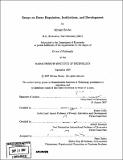Essays on entry regulation, institutions, and development
Author(s)
Bruhn, Miriam
DownloadFull printable version (11.55Mb)
Other Contributors
Massachusetts Institute of Technology. Dept. of Economics.
Advisor
Esther Duflo and Abhijit Banerjee.
Terms of use
Metadata
Show full item recordAbstract
This thesis is a collection of three essays on entry regulation, institutions, and development.Chapter 1 examines the effect of a business registration reform in Mexico on economic activity. This reform made registration procedures less complex and was implemented in different municipalities at different points in time, allowing for identification. I find that the reform increased the number of registered businesses in eligible industries. This increase was due to former wage earners opening businesses. Former unregistered business owners were not more likely to register their business after the reform. The results also show an increase in employment in eligible industries. Moreover, they indicate that the competition from new entrants lowered prices and decreased the income of incumbent businesses. Chapter 2, coauthored with Francisco Gallego, argues that within country variation in economic development across the Americas can be explained by differences in institutions that have their roots in the colonial era. Colonizers engaged in different economic activities in different regions of a country, depending on the local conditions and the supply of native labor. Some activities where "bad" since they created extractive institutions, while "good" activities created inclusive institutions. We show that areas with bad colonial activities have lower GDP per capita today than other areas. Areas with high pre-colonial population density also have lower GDP per capita today. The intermediating factor between history and current development appears to be institutions and not income inequality or the share of ethnic minorities. (cont.) Chapter 3 uses the example of Mexico's Progresa and Microrregion programs to illustrate that one can arrive at very different conclusions about the relative cost-effectiveness of public development programs, depending on the assumptions made about social opportunity costs. For Progresa, I estimate the amount of US$ required to save one life per 1000 live births to be 14.1. For the Microrregion Program, this number could fall anywhere between 7.6 and 29. The main challenge is that social opportunity costs are not necessarily equal to market prices in the presence of market failures, and that we currently lack good guidelines for how to address this issue in applied work.
Description
Thesis (Ph. D.)--Massachusetts Institute of Technology, Dept. of Economics, 2007. Includes bibliographical references (p. 157-167).
Date issued
2007Department
Massachusetts Institute of Technology. Department of EconomicsPublisher
Massachusetts Institute of Technology
Keywords
Economics.